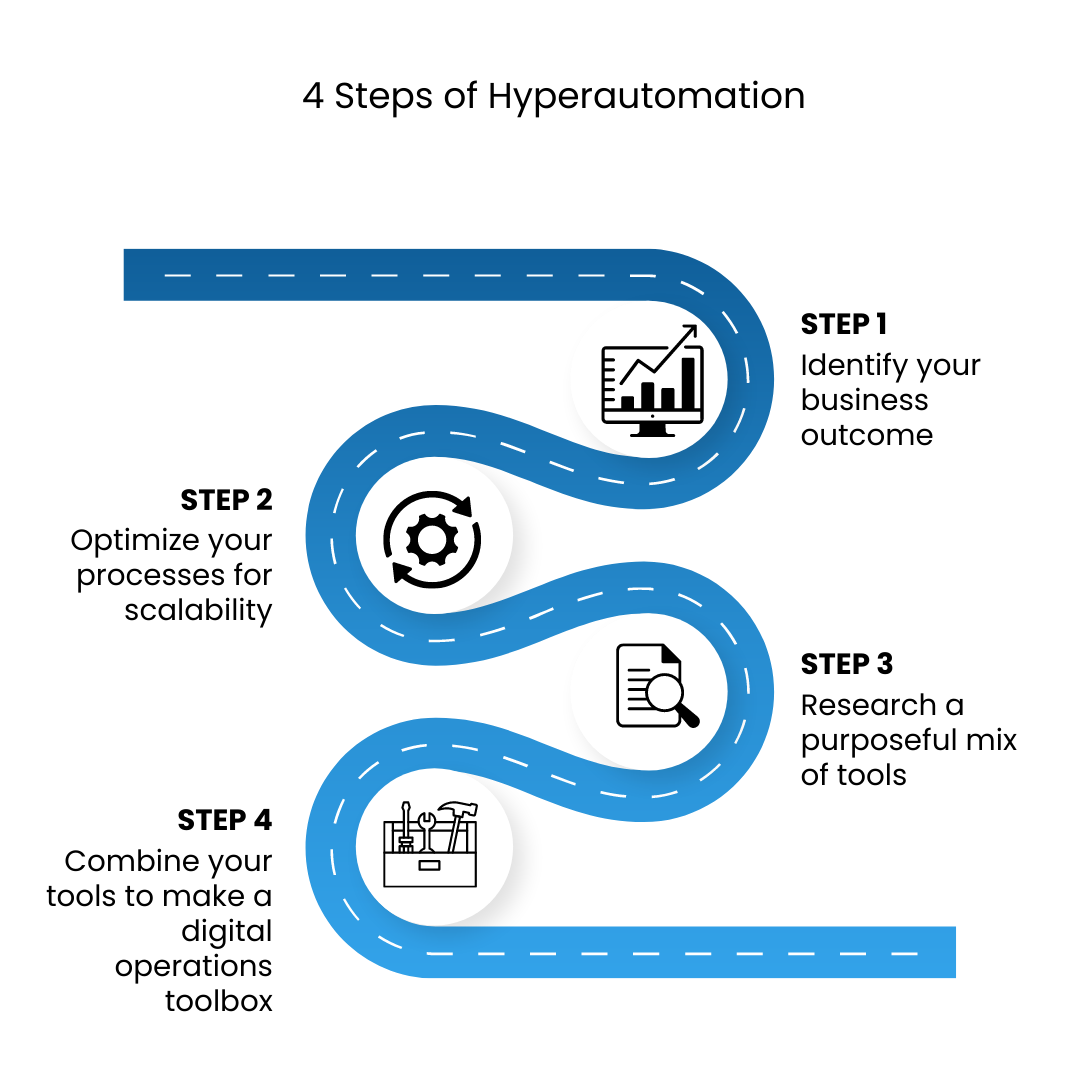A fast-paced digital landscape calls for fast-paced automation. Businesses everywhere are always adapting to stay competitive. Enter: hyperautomation. Hyperautomation combines AI, ML, and RPA to help businesses achieve high operational excellence.
What is hyperautomation?
First, let’s break down what hyperautomation is. As aforementioned, hyperautomation refers to the use of advanced automation capabilities, like artificial intelligence (AI), machine learning algorithms, and robotic process automation (RPA), to automate tasks that were once solely completed by humans.

It’s important to note that hyperautomation is not meant to entirely replace humans. Automation frees humans from repetitive tasks, allowing them to focus on more valuable tasks for the organization. Together, automation and human involvement help organizations provide superior customer experiences while increasing efficiency, reducing costs, and boosting profitability.
By using a combination of automation technologies, hyperautomation can overcome some of the limitations of approaches that rely on a single automation tool, allowing organizations to move beyond the confines of individual processes and automate nearly any tedious and scalable task.
How does hyperautomation work?
- Hyperautomation injects automated technology into every aspect of the business, as opposed to a one-off exercise. Hyperautomation includes tools for executing processes and technologies that support every stage of process automation.
- Process Discovery: Use enhanced task mining tools to monitor systems and analyze user behavior to find the most streamlined workflow.
- Analysis: Constantly identify inefficiencies or roadblocks in your systems.
- Design: Leverage dynamic what-if and digital-twin scenarios, modeling whether changes and tweaks can create systems that better meet your objectives.
- Automation: The tech behind automating manual, time-draining processes.
- Measure and Monitor: Learning how to improve strategies based on feedback and analytics,
Practitioners of hyperautomation design an entire ecosystem of automated strategies, constantly looking for fresh opportunities to enhance productivity.
Text-to-Process
When it comes to operational excellence, one hyperautomation feature has proven to transform your process building from hours to seconds. ProcessMaker’s Text-to-process feature, launched in our Summer 2023 Release, is incredibly user-friendly, making it accessible to virtually everyone.
You don’t need any technical experience to leverage this feature, making it accessible to everyone at any level. This feature is efficient in saving time. It quickly generates a process map based on your natural language description.
Tell ProcessMaker AI Modeler your desired process and a map is created almost instantly. Try it for yourself to see how easy it is.
How do you design a hyperautomation roadmap?
The most important part of any business initiative is planning. As with any business initiative, the degree of success relies on the quality of planning. Designing a hyperautomation roadmap helps cement your overarching goals and focus activities. So let’s jump into four highly effective steps to building your hyperautomation roadmap.

1. Identify your desired business outcomes
It’s important to start with the “why.” Implementing hyperautomation for the sake of exploiting a new trend is a recipe for disaster. In fact, almost 4 in 10 technology projects fail simply because teams neglected to form clear goals at the outset.
In what ways can hyperautomation most benefit your organization? Are you looking to leverage error-reducing technologies to mitigate risk? Boost revenue by offering more convenient and captivating customer experiences.
Perhaps cutting costs is your primary objective. In order to make a rock-solid plan for success, it’s essential to determine the specific goals you’re looking to achieve through hyperautomation.
The key to a successful hyperautomation deployment is the adoption of a holistic view, a sweeping vision that encompasses all individuals, departments, and processes. It’s impossible to form a hyperautomation vision in a silo, so take the time to establish how hyperautomation can benefit your entire organization, not just an individual team or process set.
2. Optimize your processes for scalability
Hyperautomation involves a wide-scale adoption of automation strategies, so it’s important to consider every opportunity through the lens of scalability. How can you streamline operations to grow other aspects of your business or expand further down the line? Hyperautomation requires a holistic approach, so it’s important to find ways to future-proof each step along the way.
3. Research a purposeful mix of tools
Ignore the temptation of buzzworthy technologies and make sure each chosen tool aligns with your desired business outcomes. Remember, the best hyperautomation strategies are not meant to completely supplant humans. Instead, hyperautomation frees high-value workers from the productivity handcuffs of rote tasks, so they’re available to take on projects where their skill sets truly shine.
For example, RPA and machine learning tools produce troves of data insights polling customer sentiments and evaluating user behaviors. However, a marketing team still needs to turn these findings into creative promotions to capture new business.
Similarly, artificial intelligence can prioritize your incoming customer service calls, sending low-priority calls to chatbots and virtual assistants. This allows your ace representatives to address more layered customer problems requiring a more nuanced approach. Find the right combination of tools for your objectives and fold them into your organization in purposeful ways.
4. Combine chosen tools into a bulletproof digital operations toolbox
At the helm of your digital transformation is your digital operations toolbox. When assigning automation tools to a broad range of activities like discovery, analysis, design, automation, and evaluation, there is an endless list of options. Consider your overarching goals and unique business use cases when finalizing your technology selection. Review technologies like:
- Robotic Process Automation (RPA): These bots are expert rule followers. They can quickly read and understand structured data to perform filing, reporting, rekeying, and copy-and-paste duties.
- Intelligent Business Process Management (iBPMS): A centralized “brain” infuses an organization’s data, systems, and people with AI, enhanced logic, and real-time analytics.
- Intelligent Platform as a Service (iPaaS): Manage the flow of integrations within the cloud and between the cloud and enterprise.
- Low-Code Tools: Accelerate the speed of app and service development by using suites of low-code tools. Instead of relying strictly on IT or esoteric programming languages, everyone on your team can contribute to development using easy, user-friendly visual building blocks.
- Artificial Intelligence and Machine Learning: While RPA is the leading expert at applying strict rules to structured data sets, AI and ML can learn from more freeform, unstructured data. This tech can learn from behaviors and outcomes to adapt and improve its knowledge base over time.
The orchestrating HQ of your hyperautomation initiative, this trove of tools contains everything you need to reach your objectives. These are the leading factors business leaders and process architects must consider when designing a hyperautomation roadmap. Using these steps to formulate your deployment strategy will set you on your way to achieving large-scale success with hyperautomation.
Hyperautomation and Hyper-Productivity™
While hyperautomation is the technology, Hyper-Productivity™ is the end goal. You can compare the two concepts to the difference between business process management (BPM) and business process automation (BPA). We all want our workflow to be as efficient and productive as possible, and bottlenecks often get in the way of that aspiration.
A powerful automation suite of IDP, Decision Engine, Business Process Automation, and AI collaborate to automate tasks, optimize processes, and boost productivity. This collaboration helps businesses overcome common challenges by relieving them of manual work and streamlining their operations. Hyper-Productivity™ means businesses can do more with less: more insights, output, efficiency, and results in less time, effort, and cost.
Overall, intelligent process automation simplifies your job by reducing manual effort, minimizing errors, improving consistency, providing better task management, and accommodating growth and change. By embracing advanced technology like hyperautomation, you can focus on higher-value activities, enhance productivity, and achieve better outcomes in your work. Chat with us to learn more about BPA and which software is right for you. At the end of the day, your company deserves to find the right fit, even if it isn’t us!





